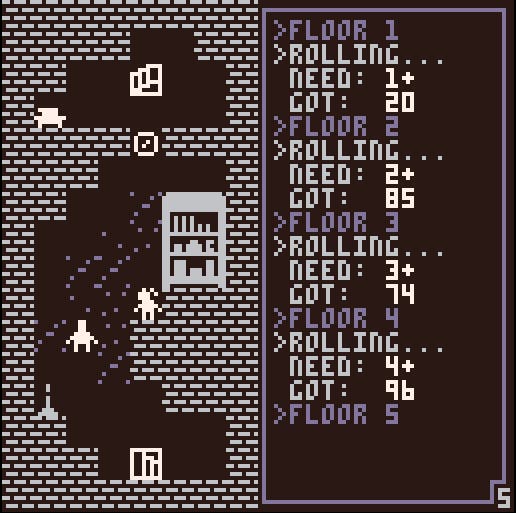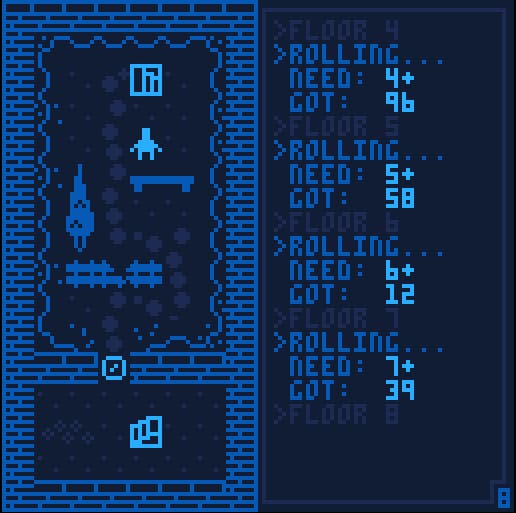The Tower is brilliant - and a bit about AI chatbots
Going up?
The Tower is exactly my kind of thing. It's a Pico-8 game created by the luminously talented designer Tallywinkle, and I've been playing it on-and-off since last week. I think on-and-off is actually the best, and perhaps the only true, way to enjoy this.
And the idea is simple. You're climbing a tower one floor at a time. Each floor has a staircase that's generally blocked off by a random-number-generator dice roll of one to 100. If I roll the dice and the number is equal to or higher than the number of the floor I'm on, I can go up the stairs to the next floor. If the number is lower, then the stairs take me down to the floor below and I have to try to go up again.
A few things here. The Tower won me over from the moment that it announced itself via a friend, the dep-ed of Edge, as a game about climbing a tower. This is something I never tire of in games. Crackdown, Arkham, I just love a good tower. But I love this tower all the more because of its chunky pixels and rich, Pico-8 colours - those lurid magentas and neon greens - and the glitchy presentation which sees the colours themselves pied and strobing as ghostly scan lines move up and down, which sees characters and items suddenly pop into existence and then disappear again.

It reminds me, very strongly, of games like Jet Set Willy, the home computer classic in which you set off in a top hat and with a hangover to explore a very strange house. I love that game for its sense of mystery - a sense that there is meaning here, meaning that would enrich my life, but it's always just out of reach. I didn't talk to anybody in Jet Set Willy but I spent hours exploring its halls and chambers. I can talk to people in The Tower, but I don't always learn that much. Instead, it's always: what's next? And how does this all fit together? One floor is a grotto. Another is a library, or a dining room, or an attic, with unmistakable pixel-art floorboards. Or a farm. Or a forest.
There's a wonderful, energising thin-ness to the staging, I think, almost like you're going through a primary school's prop room containing background settings from generations of school plays, and they're all shuffled together in strange ways. There's something so clever about it all too. By the mid-point of the game, when it starts to become a real challenge to progress higher each time, because the floor number is already pretty high itself, I start to meet people in the tower who have forgotten how and why they started climbing. By this point, of course, I have been back and forth myself so much - floor 52 back all the way to 47, up as high as 58 - that I am losing my memories of the early stages of the journey as well! This is harmony!
Speaking of harmony, while I've been playing The Tower, I've been reading a bit about Bing and its new AI. I read a piece in The Verge about how undeniably intelligent people keep falling for the trick, thinking that a chatbot that effectively functions as a form of auto-complete - I did not know this - is, if not sentient, well, something rather special and spooky anyway.

The Verge piece traces this phenomenon as far back as the 1960s and ELIZA, an early chatbot that could only repeat stock phrases, but still managed to convince users that they had glimpsed something more moving within the machine.
Of course, I tell myself, I would never fall for that. Not now that I've read this piece in The Verge, anyway, and can pass its insights off as my own in conversation and in pieces like this. And yet as I smugly go back to my day, I play The Tower, and, without noticing, I start to obsess about the dice rolls that move me between each floor. The random numbers. I start to see patterns in them. If I get too many high numbers, I stop for a bit, because I imagine that the system will try to stop my fun. If I get too many low numbers, I keep playing, because The System - which has now earned capital letters - is toiling behind the scenes, keeping me in the cat's cradle of its cruel logic, and ready to dish out a few easy victories.
It goes deeper. I start to see patterns in the dance of the numbers themselves - 87 to 45 feels kind of right! 7 following a rare 100 seems to speak to me in some way. And beyond the numbers too? The sound often glitches in The Tower just like the colours and the art. And I have started to see doomy significance in this. If the sound of the text rattling out on the screen is high and clear like a machine-gun, that means the number will be high, that I am satisfying The Tower's requirements in some way. If it's muffled and quiet, I'm going to get a low number and head back the way I came.
The more I play, in other words, the more I see an imaginary world of order around these dice rolls. And all because I want to get to the top of the tower.

